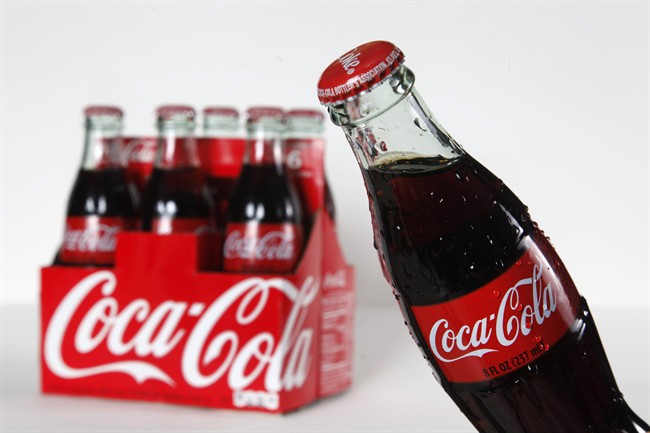NEW YORK – Coca-Cola, the world’s biggest beverage maker, said Tuesday that the amount of soda it sold globally fell for first time in 15 years.

The drop was offset by stronger sales of some of its noncarbonated drinks that include Minute Maid, Powerade and Dasani bottled water, and overall volume of drinks sold rose 2 per cent.
But the decline across the globe is significant for Coca-Cola: The last time worldwide soda volume declined was in 1999, according to the company.
Gary Fayard, the company’s outgoing chief financial officer, attributed the decline in sodas partly to the timing of Easter, which falls in the second quarter this year instead of the first.
“It’s not as concerning to us as it would look at first pass,” he said in a phone interview.
He also cited a double-digit soda decline in Great Britain, where the company stood by its pricing despite switching to smaller bottles. For the full year, Fayard said he expects global soda volume to be positive.
READ MORE: Pop sales in North America declining at faster pace
The decline in global soda volume comes as Coca-Cola increasingly is relying on non-carbonated beverages to boost sales as sodas continue to face pressure, both at home and abroad. In developed nations like the U.S., soda has been under fire for years over concerns that it fuels weight gain. More recently, executives have blamed declines in diet sodas to concerns about artificial sweeteners.
- Posters promoting ‘Steal From Loblaws Day’ are circulating. How did we get here?
- Canadian food banks are on the brink: ‘This is not a sustainable situation’
- Is home ownership only for the rich now? 80% say yes in new poll
- Investing tax refunds is low priority for Canadians amid high cost of living: poll
For the quarter, Coca-Cola’s soda volume slipped 1 per cent in North America and 5 per cent in Europe. It also took a hit in Mexico as the country instituted a tax on the sugary drinks, although the company didn’t specify the severity of the decline.
For now, sodas still account for 75 per cent of the company’s case volume outside the U.S. Overall, 81 per cent of the company’s case volume comes from overseas.
Going forward, CEO Muhtar Kent stressed during a call with reporters that the company would pursue “balanced growth between stills and sparkling,” as well as different regions of the world.
Coca-Cola isn’t alone in its struggles to boost soda sales. PepsiCo Inc., which reports its quarterly results Thursday, has suffered even steeper declines despite stepped-up marketing, including sponsorship of the Super Bowl halftime show.
Although both companies sell a wide array of beverages, sodas remain a big part of their businesses and they’re scrambling to figure out ways to stop the declines even as they rely more heavily on other types of drinks.
In the year ahead, Coca-Cola plans to increase its marketing budget by $400 million to “north of $4 billion,” Kent said. The company also introduced a version of its namesake soda sweetened with a mix of stevia and sugar in Argentina, with plans to eventually introduce the drink elsewhere.
For the quarter that ended March 28, unfavourable currency exchange rates contributed to an 8 per cent decline in profit.
Adjusted for such one-time factors, earnings per share were in line with Wall Street expectations and Coca-Cola shares rose 3 per cent to $40.09.
Coca-Cola’s net income fell to $1.62 billion, or 36 cents per share. That compares with net income of $1.77 billion, or 39 cents per share a year ago.
Excluding one-time items, net income was 44 cents per share, matching analyst expectations.
Revenue fell 4 per cent to $10.58 billion, but was above the $10.5 billion Wall Street expected.
Companies like Coca-Cola that do a large portion of their business overseas take a hit to revenue when the dollar is strong, because foreign currencies convert back into fewer dollars.



Comments